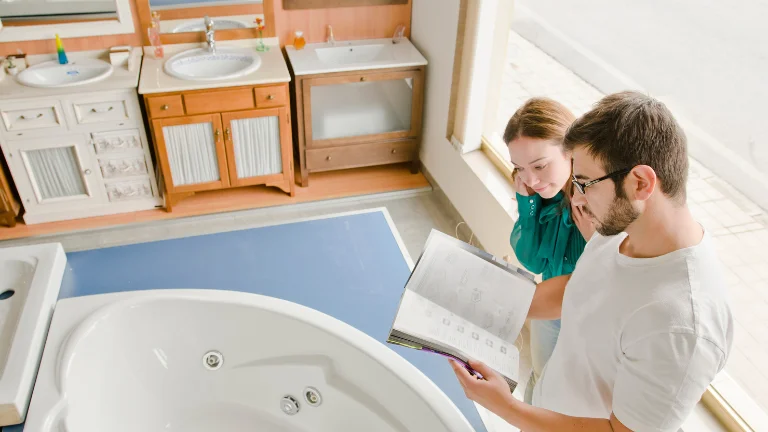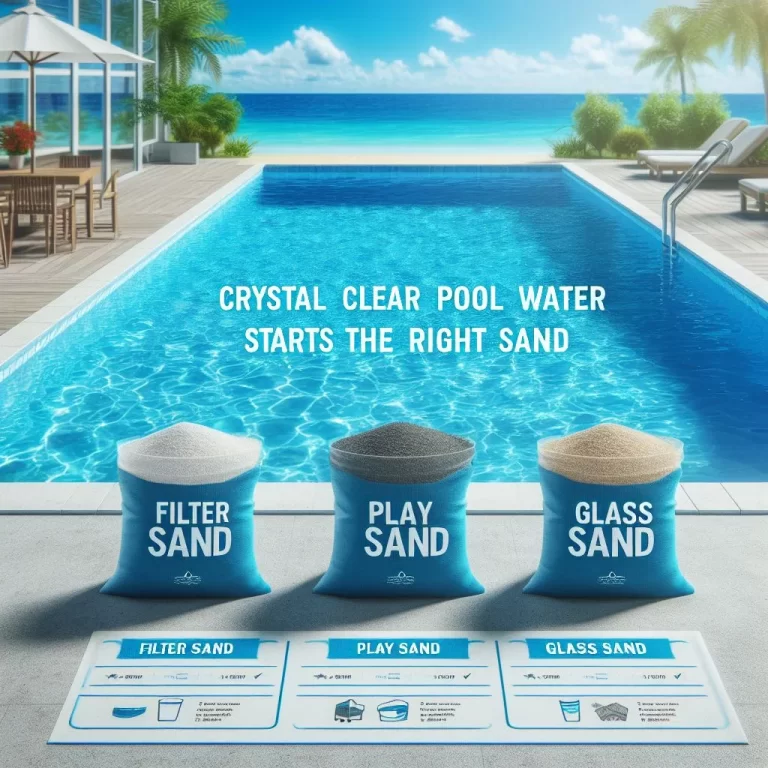Modern Sauna Design Ideas
Modern sauna design is all about clean wood lines, soft LED lighting, and simple layouts that feel calm the second you step in.
Most people go with cedar or hemlock because they stay cool to the touch and look great with glass doors or full glass walls. Floating benches, hidden lights, and compact corner layouts help a sauna feel bigger without taking up more room.
Outdoor setups use the same modern style but lean on barrel shapes or frameless glass for a spa vibe in the backyard.
- What Is a Modern Sauna?
- 5 Modern Sauna Design Ideas
- Common Types of Saunas for Home Spas
- Key Considerations in Sauna Design
- Before You Start: Quick Design Checklist
- Popular Modern Sauna Design Styles
- Modern Sauna Cost Breakdown
- Modern Sauna Layout Ideas (Indoor and Outdoor)
- Aesthetic Design in Modern Saunas
- 🔎 Modern Sauna Aesthetics
- Sauna Use: Stats and Facts
- Health and Wellness Benefits of Modern Sauna Design
- FAQs
If you’re choosing a design, think about your space, how much heat you like, and whether you prefer traditional heat or a modern infrared setup.
Modern sauna design for home spas focuses on functionality, space efficiency, materials like cedar or hemlock, options between traditional and infrared systems, proper ventilation, lighting, and integration with home décor. Key factors include safety, size, energy use, and personal wellness needs.
What Is a Modern Sauna?
A modern sauna is a heated, enclosed space designed for relaxation and wellness, often featuring sleek materials, energy-efficient systems, and customizable layouts for home use. Unlike traditional designs, modern saunas often integrate glass, LED lighting, and compact builds that fit smaller spaces.
5 Modern Sauna Design Ideas
1. Minimalist Scandinavian Sauna
Simple, clean wood tones with soft lighting and a calming atmosphere.
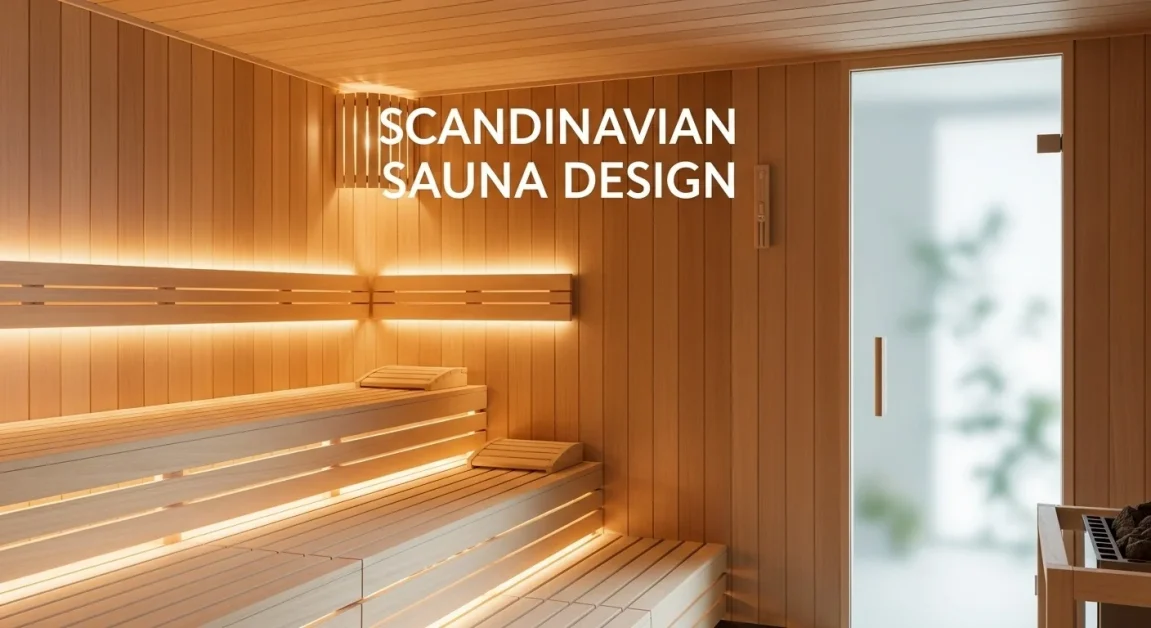
2. Glass-Walled Modern Sauna
A sauna with large glass panels for a spacious, open feel.
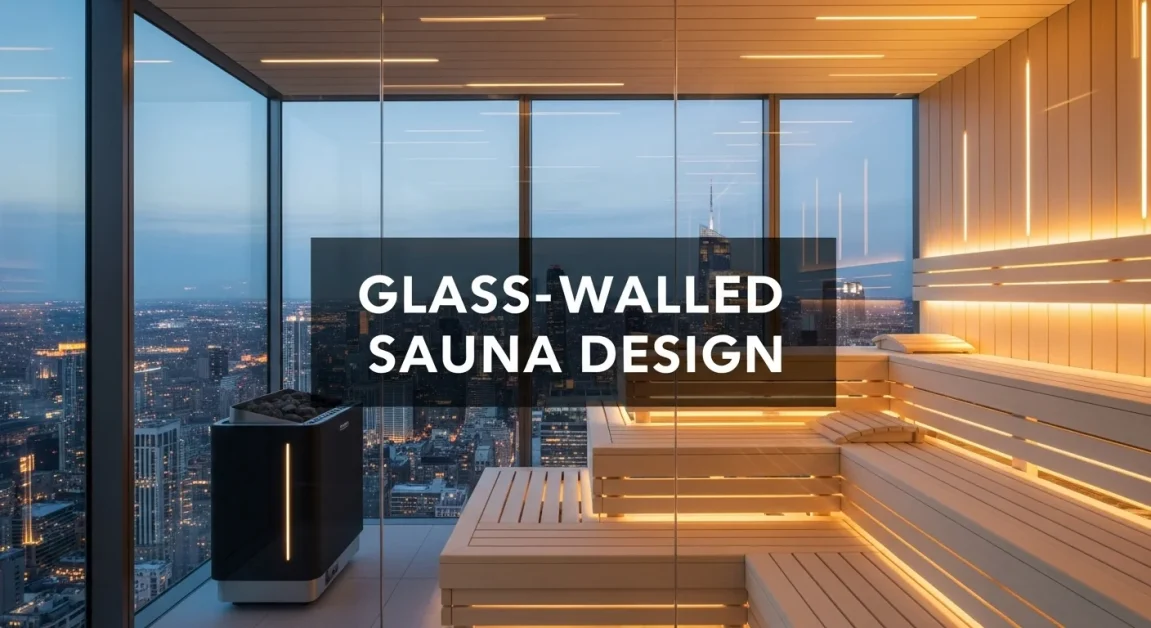
3. Outdoor Barrel Sauna
Rustic, rounded barrel-shaped sauna for outdoor patios or gardens.
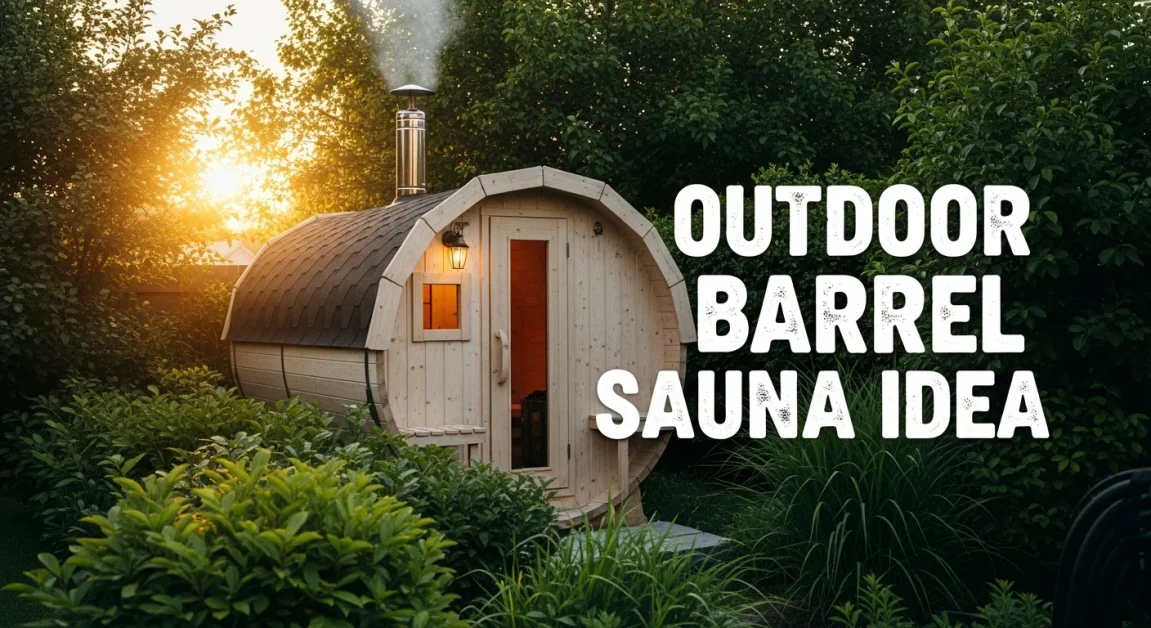
4. Compact Corner Sauna
Space-saving sauna that fits neatly into a bathroom or small room corner.

5. Luxury Spa-Inspired Sauna
High-end design with mood lighting and integrated features.
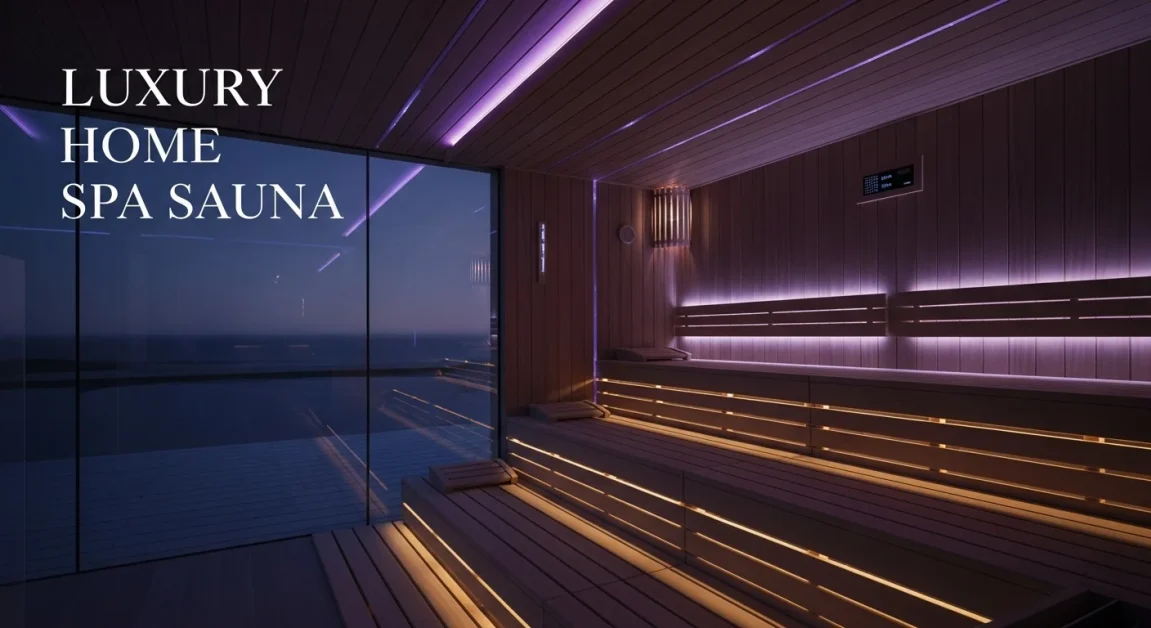
Common Types of Saunas for Home Spas
| Sauna Type | Heating Method | Typical Design Features | Best For |
|---|---|---|---|
| Traditional Sauna | Wood-burning or electric | Wood interiors, high heat, steam option | Authentic sauna experience |
| Infrared Sauna | Infrared heaters | Lower temperatures, modern panels | Gentle heat, energy efficiency |
| Steam Sauna | Steam generator | Enclosed, high humidity environment | Skin hydration, relaxation |
| Portable Sauna | Electric heat panels | Compact, foldable or tent-like | Small spaces, temporary setups |
Key Considerations in Sauna Design
1. Size and Space
- Small home saunas: often fit 1–2 people, good for apartments.
- Larger builds: can fit 4–6 people, suitable for basements or outdoor patios.
2. Materials
- Cedar and Hemlock: popular for durability, heat resistance, and aroma.
- Glass Panels: used for doors or walls to give a modern, open look.
- Insulation: critical for energy efficiency and maintaining consistent temperatures.
3. Heating System
- Traditional: higher temperatures (160–200°F) with steam option.
- Infrared: lower temperatures (120–140°F), direct heating of the body.
4. Ventilation
- Proper airflow reduces mold growth and improves comfort.
- Recommended: adjustable vents for temperature control.
5. Lighting and Ambiance
- Soft, dimmable LED lights for relaxation.
- Options for color therapy (chromotherapy) in some modern designs.
6. Safety Features
- Heat-resistant glass for doors.
- Automatic shut-off timers.
- Non-toxic materials to avoid harmful fumes.
Before You Start: Quick Design Checklist
It’s easier to build a modern sauna when you have a clear plan. This quick checklist helps you figure out what will actually work in your home instead of guessing and hoping it fits.
1. Measure Your Space
Know the exact width, height, and depth of the room or corner.
Most modern saunas need at least 4 ft x 4 ft, while larger indoor builds use 5 ft x 7 ft or more.
2. Choose Your Heating Style
Pick the heat type before choosing the layout.
It affects wiring, ventilation, and energy use.
● Traditional (hotter, steam option)
● Infrared (gentler heat, lower energy use)
If you’re not sure which fits your home, this guide helps: Which sauna is right for me?
3. Pick Your Wood Tone
Light cedar gives a clean Scandinavian feel.
Darker woods create a more dramatic spa look.
Make sure the wood you choose is heat-stable and low in resin.
4. Decide How Much Glass You Want
Glass makes a sauna look modern and open, but it also loses heat faster.
Frameless doors look sleek but cost more.
Good rule of thumb, keep at least one solid wall for better heat retention.
5. Plan for Ventilation
Modern saunas still need steady airflow.
Add vents near the heater and one higher up so the room stays balanced.
6. Think About Lighting Early
Hidden LED strips, corner lights, and soft ceiling glows all work great,
but they must be heat-rated and installed before the walls close up.
7. Check Power Requirements
Most indoor saunas need a 240V line, especially traditional ones.
Infrared often works on 120V, which saves you on wiring.
8. Match the Sauna to Your Home Style
If your home has clean white walls and natural wood floors, match those tones inside the sauna.
Outdoor builds should also match the patio or backyard features.
9. Set a Real Budget Range
Most modern home saunas land between $3,000–$12,000, depending on glass, heaters, and custom work. Having a number in mind makes design choices easier.
Popular Modern Sauna Design Styles
- Minimalist Scandinavian: clean wood lines, natural tones, and simple layout.
- Glass-Walled Sauna: modern, open feel; blends with contemporary interiors.
- Outdoor Barrel Sauna: rounded wood design, suitable for gardens or patios.
- Compact Corner Sauna: space-saving option for small bathrooms.
Modern Sauna Cost Breakdown
Glass walls and custom lighting push the price higher, while simple wood interiors keep things affordable. Here’s a quick look at what most people spend.
Typical Price Ranges
| Sauna Style | Average Cost | What Affects the Price |
|---|---|---|
| Compact Corner Sauna | $1,800–$3,500 | Size, glass door, LED lighting |
| Indoor Modern Sauna (2–4 person) | $3,500–$7,000 | Wood type, ventilation, heater type |
| Glass-Walled Sauna | $6,000–$12,000 | Full glass panels, frameless doors, custom benches |
| Outdoor Barrel Sauna | $4,500–$10,000 | Wood thickness, heater, insulation, location setup |
| Luxury Spa-Style Sauna | $10,000–$22,000+ | Custom builds, floating benches, mood lighting, specialty wood |
Installation Costs
Most homeowners spend an extra $800–$3,000 on setup.
This usually covers:
● Electrical work for the heater
● Ventilation adjustments
● Floor prep and insulation
● Assembly and sealing
Outdoor builds may require a pad or foundation, which adds $300–$900.
Operating Costs
Your monthly cost depends on the heater and insulation.
● Traditional electric sauna runs about $20–$40 per month with normal use.
● Infrared sauna is usually cheaper, around $10–$20 per month.
● Outdoor saunas can run slightly higher because they lose more heat to the air.
If you want exact numbers based on your heater size, you can use tools like a
sauna heater size calculator for a more accurate estimate.
What Raises the Price Fast
● Full-glass walls or frameless doors
● Custom lighting setups
● Upgraded woods like walnut or thermally treated options
● Larger heaters
● Built-in sound or aroma systems
● Custom bench layouts
Most Budget-Friendly Options
If you’re trying to keep cost under control, stick with:
● Hemlock or cedar interiors
● A standard glass door instead of a full glass wall
● Basic LED strip lighting
● Two-person size
● Infrared heat panels
Modern Sauna Layout Ideas (Indoor and Outdoor)
Modern sauna layouts focus on clean lines, simple wood tones, and smart use of space. Whether you’re working with a small bathroom corner or a full backyard spot, the right layout makes the whole sauna feel bigger and more relaxing.
1. Compact Corner Layout
Great for bathrooms, basements, or any small room.
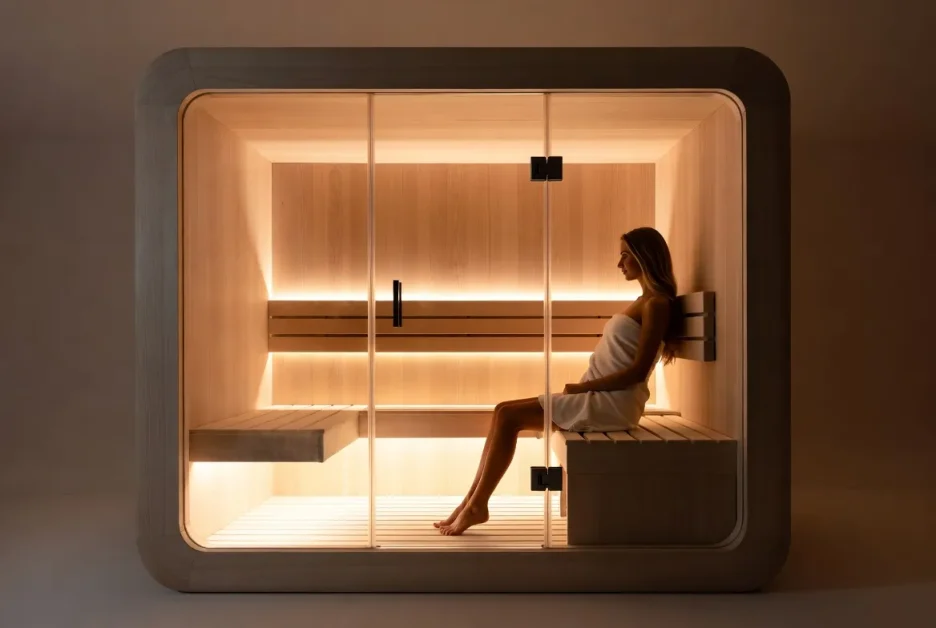
What it looks like:
● Glass door in front
● Benches on one side
● Soft LED lighting tucked under the seat
Why people like it: It fits in tight spaces without looking cramped.
2. Floating Bench Layout
This is a big trend in modern saunas.

What it includes:
● Benches mounted to the wall with no visible supports
● Hidden LED lighting underneath
● Clean, open floor space
Why it works: It gives a high-end spa feel and makes the room look larger.
3. Glass-Walled Layout
Perfect if you want a sleek, open look.

Design details:
● One or two full glass walls
● Frameless door
● Minimalist wood ceiling and benches
Things to know: Glass opens the space but may need a stronger heater to keep heat steady.
4. Two-Level Bench Layout
A classic setup with a modern twist.

Usually includes:
● A lower bench for cooler seating
● An upper bench for hotter sessions
● Straight lines and matching wood tones
Why it’s popular: It gives you flexible heat levels in the same session.
5. Outdoor Barrel Layout
A clean modern style even though the shape is rustic.
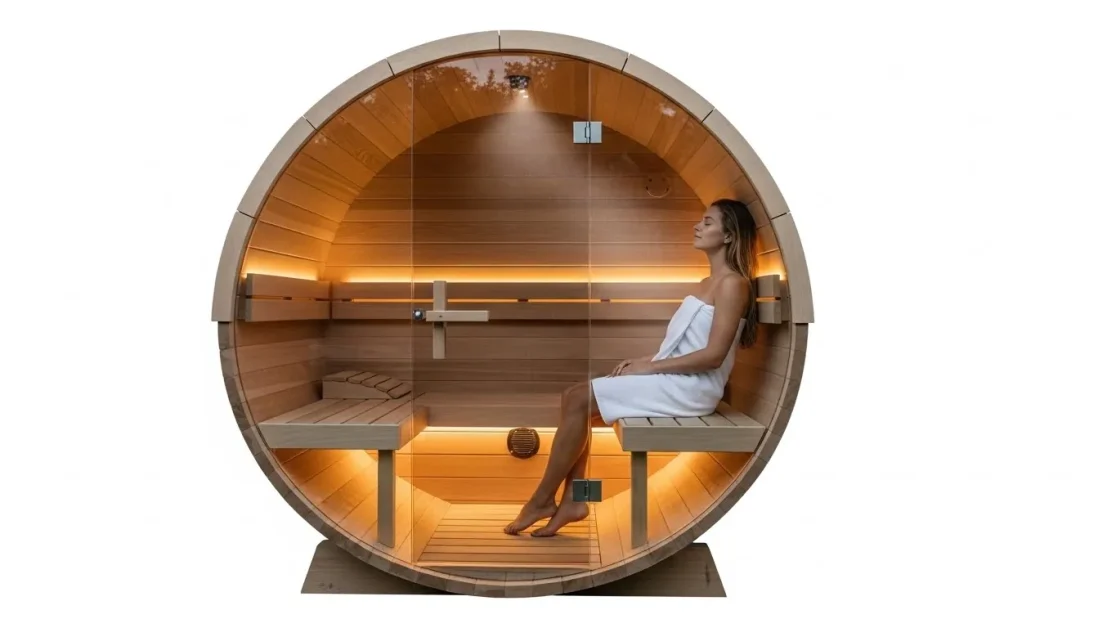
Common features:
● Rounded cedar or hemlock shell
● Clear glass door
● Wide bench seating inside
Best for: Patios, backyards, and homes where indoor space is tight. If you’re leaning toward this style, this guide has helpful ideas: outdoor sauna
6. Full-Length Window Layout
A stylish option for outdoor saunas.

What you’ll see:
● Floor-to-ceiling glass at one end
● Dark or light wood interior
● Soft glowing lights
Why it stands out: You get a full view of your yard, woods, or landscape.
7. Spa-Inspired Luxury Layout
High-end details that raise the look instantly.
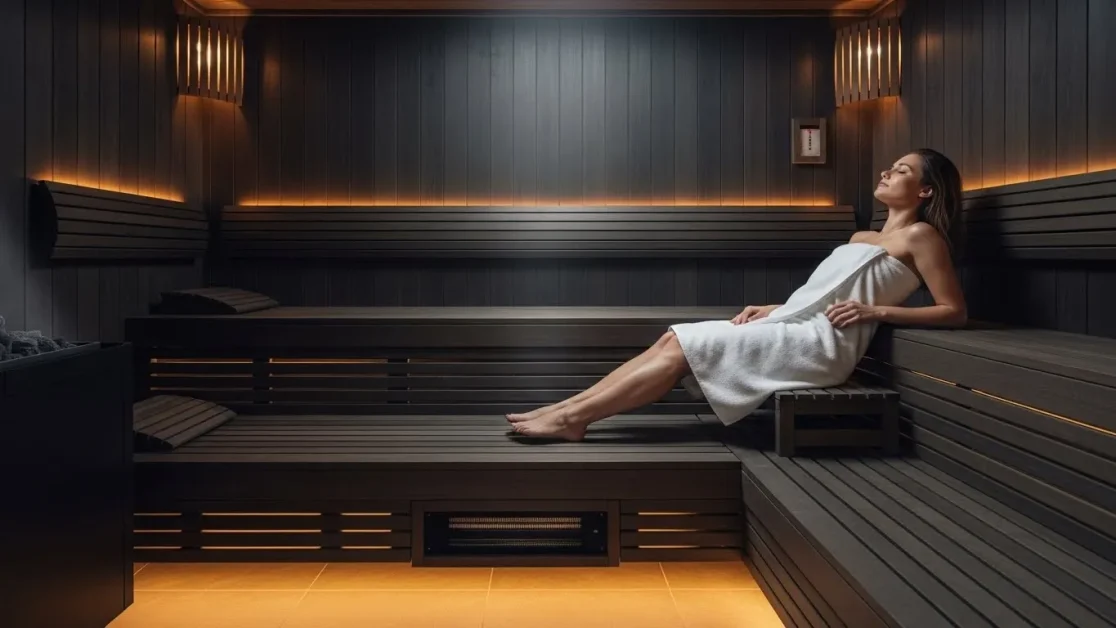
Includes things like:
● Backlit walls
● Dark thermo-treated wood
● Built-in sound system
● Hidden heater box
Who chooses it: Homeowners building a dedicated wellness room.
8. Bathroom Integration Layout
Blends the sauna with the rest of the bathroom.
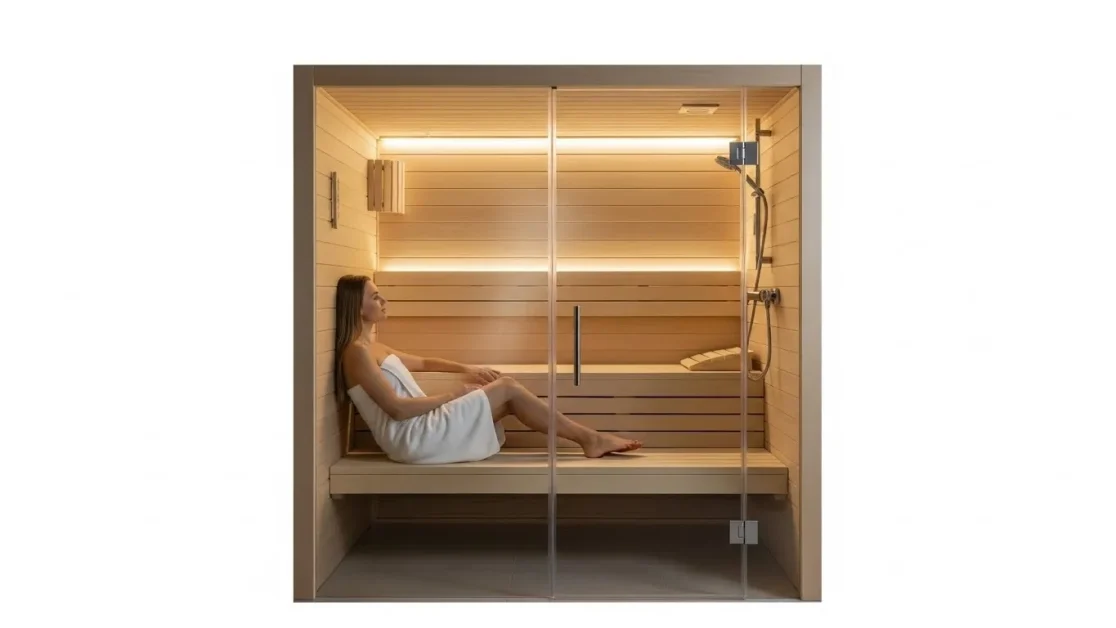
Design touches:
● Matching tiles or wood tones
● Glass door that lines up with shower glass
● Soft strip lighting along the top
Works best with: Moderate to small bathrooms where one wall of the sauna becomes part of the bathroom style.
Aesthetic Design in Modern Saunas
Modern sauna design is not only about function but also about how the space looks and feels. The aesthetic choices can shape the overall atmosphere and influence how relaxing the sauna experience becomes.
Key Elements of Sauna Aesthetics
- Wood Selection
- Light woods such as cedar or hemlock create a bright, clean appearance.
- Darker woods such as walnut or thermo-treated options give a more dramatic, luxury feel.
- Glass Features
- Full or partial glass walls open the space visually, making small saunas appear larger.
- Frosted or tinted glass can add privacy while keeping a modern look.
- Lighting
- Soft LED strip lights along benches or ceilings provide a warm glow.
- Adjustable color therapy lighting offers mood flexibility.
- Layout and Lines
- Minimalist Scandinavian styles favor clean horizontal bench lines and uncluttered walls.
- Rounded corners or curved benches can soften the interior and add comfort.
- Integration with Home Décor
- Modern saunas are often designed to blend with bathrooms, basements, or outdoor patios.
- Neutral tones and natural textures help connect the sauna with the rest of the home’s style.

Practical Considerations
While aesthetics improve the overall spa-like experience, design choices should remain practical:
- Materials must be heat-resistant and low in maintenance.
- Lighting should be safe for high-heat conditions.
- Glass features should use tempered or laminated safety glass.
🔎 Modern Sauna Aesthetics
Quick comparisons to choose finishes & layouts.
🪵 Wood Tone Finish
- Bright, open feel
- Hides scratches
- Works with glass
- Cozy, dramatic
- Shows dust
- Needs strong lighting
Tip: use heat-stable finishes only.
🪟 Wall Style Layout
- Opens rooms
- Tempered glass
- Slight heat loss
- Retains heat
- Privacy
- Heavier look
Add vents for airflow control.
✨ Layout & Lighting Style
- Clean lines
- Hidden LEDs
- Low upkeep
- Layered lights
- Wider benches
- Custom features
Use heat-rated fixtures & timers.
Note: Colors for contrast only use heat-safe materials.
Sauna Use: Stats and Facts
- Frequency of Use: A 2018 study from the University of Eastern Finland reported that people who used a sauna 4–7 times per week had a 50% lower risk of fatal heart disease compared to those who used it once per week.
- Blood Pressure: Regular sauna bathing (2–3 times per week) was associated with a 24% lower risk of high blood pressure in the same study group.
- Skin Health: Dermatology surveys note that sauna sessions can increase skin hydration by up to 15% after consistent use, due to increased blood circulation and sweating.
- Calorie Burn: Sitting in a sauna at 160–180°F for 30 minutes can burn approximately 100–150 calories, though this varies based on body weight and metabolism.
- Global Popularity: An estimated 16,000 public saunas exist in Finland, serving a population of 5.5 million, roughly 1 sauna for every 3 households.
Sauna Use: Stats and Facts
(Each bar is scaled relative for visual impact)
Health and Wellness Benefits of Modern Sauna Design
This section would connect design choices (like glass walls, lighting, or infrared systems) with practical health outcomes, making the guide more complete.
For example:
- Lighting → soft LED or chromotherapy can influence mood and relaxation.
- Materials → cedar wood resists mold, supporting cleaner air.
- Ventilation → proper airflow reduces humidity-related risks.
- Temperature Control → adjustable systems help different users customize comfort.
Find More Healing in Style
Relax like never before with our expert tips and top-notch solutions for ultimate relaxation.
Hot Tub Patio Insights
Check out simple tips and creative ideas to build your dream outdoor retreat with Hot Tub Patio.
Learn More
